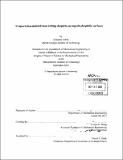Evaporation-induced non-wetting droplets on superhydrophilic surfaces
Author(s)
Adera, Solomon (Solomon E.)
DownloadFull printable version (14.14Mb)
Other Contributors
Massachusetts Institute of Technology. Dept. of Mechanical Engineering.
Advisor
Evelyn N. Wang.
Terms of use
Metadata
Show full item recordAbstract
A droplet deposited on a rough, lyophilic surface satisfying the imbibition condition, results in spontaneous spreading and hence complete wetting. However, in this thesis, we demonstrate that this wetting behavior can be altered by superheating the substrate such that droplets can reside in a non-wetting state due to evaporation. Photolithography and deep reactive ion etching were used to fabricate well-defined silicon micropillar arrays with a square pattern with varying pillar diameter, height, and center-to-center spacing. Water droplets placed on these microstructured surfaces at room temperature demonstrated superhydrophilic behavior with liquid filling the voids between pillars resulting in very low contact angle, and hence complete wetting. However, when the microstructured surface was superheated above a critical superheat, the superhydrophilicity was lost and non-wetting droplets were formed on the top surface of the micropillar array structure. The superheat required to deposit a non-wetting droplet (> 75°C) was found to be significantly higher than that required to sustain an already deposited non-wetting droplet (< 35°C). Moreover, the superheat required to sustain a non-wetting droplet after the initial deposition was observed to decrease with the square of the droplet radius. A 1-D lubrication type model based on a force balance between the wetting and non-wetting forces is developed which explains the mechanism by which non-wetting droplets can reside on superhydrophilic surfaces at superheated conditions due to induced evaporation. Moreover, the model predicts a square relationship between the superheat required to form non-wetting droplets and the droplet radius which is in agreement with experimental observation. These observations where non-wetting droplets reside on superhydrophilic surfaces at superheated conditions have implications for phase-change based heat transfer applications where the loss of contact between the substrate and the heat transfer fluid could be detrimental to the device performance.
Description
Thesis (S.M.)--Massachusetts Institute of Technology, Dept. of Mechanical Engineering, 2012. "September 2012." Cataloged from PDF version of thesis. Includes bibliographical references (p. 66-68).
Date issued
2012Department
Massachusetts Institute of Technology. Department of Mechanical EngineeringPublisher
Massachusetts Institute of Technology
Keywords
Mechanical Engineering.